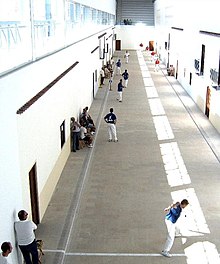Llargues
Llargues(Valencian pronunciation:[ˈʎaɾɣes],"long ones" ) is the oldestValencian pilotamodality. It is played on the streets, where two teams formed by 3, 4 or 5 players throw each other the ball with the hand try to surpass an imaginary line which changes every game.
There are no professional players, but it is very common in the towns and villages of some regions of theValencian Community,such as theMarina AltaandBaixa,l'Alacantí,l'Alcoiàand theComtat.

Playing area[edit]

The chosen place must be a plain, straight, wide and long street, measuring 70 m at most. If one of the sides is upset the downside will be assigned to the "rest", the same if one of the sides is wider.
Street is limited by two lines: thebancalineand therest linewhich mark the end of both sides. There is also another line, thefault linewhich signals the point the ball must surpass when serving, at 40 m from therest.In case one of the playing teams is clearly stronger they maygive some steps,that is, to allow thebanca lineto be a bit more advanced in order to compensate for the stronger opponent serve.
Spectators may sit on the sidewalks and behind the street end lines.
Ball[edit]

Llarguesare played with abadana ball,which can be played without any protection. Since this sport is practiced on the streets and the bounce is very irregular this kind of ball almost does not bounce. They are cheap, so it does not matter if any ball is lost on the roofs, at another street or in any balcony (which happens often). Also, streets have plenty of irregularities such as borders or traffic signals, and many places with a different rebound (walls and doors, ground or gutter lids), that cause strange effects to the trajectory of the ball; those unexpected directions are somehow minimized by the soft rebound of thebadana ballsince it is made of moulding materials. Another reason to use this ball is its slowness and softness, so that it is proper for amateur or casual players.
The badana ball is made of rags withsheepskin.Weight: 39 g., diameter: 38 mm.
Rules[edit]
Two teams formed by 4 or 5 players try to attain a certain score (usually 10 points) by throwing each other a ball with the hand so that the opposing team is not able to send it back. Not so long ago there was another scoring system called "up and down" (a pujar i baixar), where the team who was losing subtracted points to the winner.
Teams wear red and blue T-shirts, with red being the colour of the team allegedly stronger or favoured in the betting.
Players receive a name depending on their position on the street:
- Thebancais in charge of beginning everyquinzeby serving, from one side of the street.
- Therest,from the other side of the street, is who usually returns the banca' serve. Both players are the stronger pilotaris.
- Themitgeris in the middle of his midfield, his purpose is sending the ball as far as possible.
- Thepunteris in front of the opposing team or into their midfield, he must block the ball or throw it to the non-protected places.
Every point consists of fourquinzes:15, 30,val,andjoc.The team who wins thejocscores a point.

Thequinzebegins when thebancaserves: From the other side of thebanca linethe player must send himself the ball and (without any bounce) hit it to throw it so that it surpasses thefault linewithout touching the ground, then the opposing team may hit it back or block it so that it does not advance further.
Inllarguesthe ball must be hit with the hand when it is in the air or after its first rebound on the ground, to send it to the opposing team's field or behind the line that marks the end of the street. When the player blocks the ball he may touch it with any part of his body (but only after the second bounce), in that case alineis done on the ground (actually, a signal is placed on the sidewalk). It is the basic principle of thegames of gain-ground.
The main feature ofLlarguesare theratlles(Valencianforlines), the signals set in the place where the ball has been blocked everyquinze.The ball may be blocked because it's been thrown to the spectators and hasn't come back to the playing area, or, more likely, because a player has chosen to stop its advance when he realized he can not hit it back properly. In case the ball gets blocked on any roof or balcony thequinzeis lost for whoever sent it there.
When a team has got 2ratllesteams change the fields; they will try to score those pending points. Also, if thebancateam gets avalthey must change the field, even if they have only oneratlla.
When serving, they try to get directquinzesor win the pendingratlles.Thoseratllesare now thefault line.This way, the farther they have moved theratllathe more places they have to defend the opponent and the more non-protected areas there will be.
Directquinzesare scored when:
- a team send the ball behind the opponent's street end line.
- or because afaultof the opponent:
- If the ball bounces twice.
- If a player touches the ball twice, or a player of the same team touches it after one hit.
- If thebancaplayer does not reach thefault line.
A palma[edit]
A palmais aLlarguesvariant where the only difference is the serve. Since there are so many goodbanques,the serving is donea palma(with the palm), that is, the arm is extended long. This way, the serving strike is not so strong and teams are likely to be more equal.
Perxa[edit]
ThePerxashares the same rules than theLlarguesvariant except for the serve. The serve is done from thefault linethrowing the ball over a rope (as seen on theGalotxavariant) to a square drawn on the ground.
